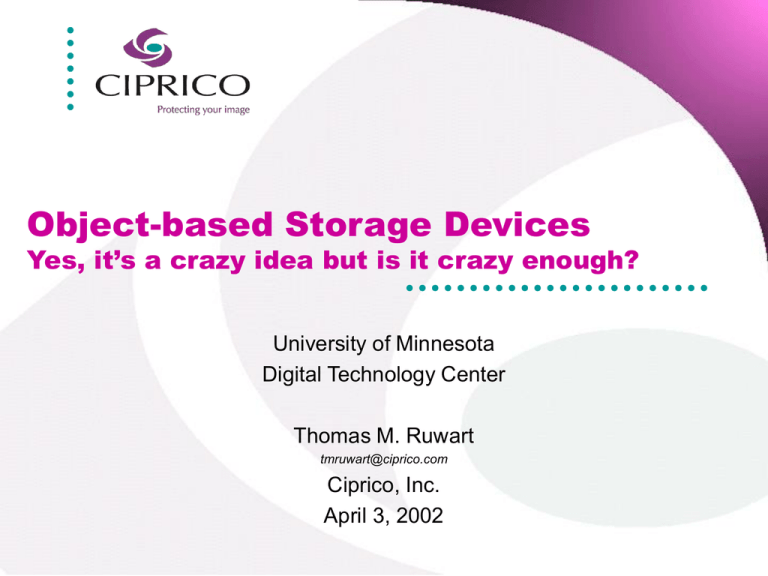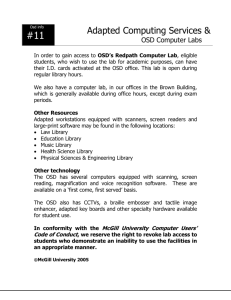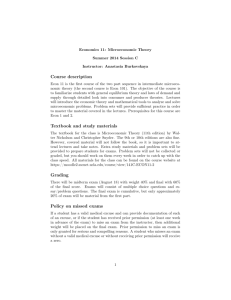Slide presentation (powerpoint 298 KB)
advertisement

Object-based Storage Devices Yes, it’s a crazy idea but is it crazy enough? University of Minnesota Digital Technology Center Thomas M. Ruwart tmruwart@ciprico.com Ciprico, Inc. April 3, 2002 Overview • • • • • • What is OSD? What problem(s) are we trying to solve? Why would you want to use OSD? Example OSD Scenarios Current OSD-like implementations Issues with OSD Ciprico 2 What is OSD? • Object-based Storage Devices – An Enabling Technology • Grew out of the Network Attached Secure Disks (NASD) project at CMU • A flexible and powerful protocol used to communicate with storage devices • Proposed as a protocol extension to the SCSI command set • Actively being pursued by the OSD Technical Working Group in the Storage Networking Industry Association (SNIA) • It is a natural step in the evolution of storage interface protocols • For some however, it is very new and very different 1902 1985 1990 1998 ST506 SMD SCSI FC SCSI Ciprico 2002? SCSI OSD 200X OSD 3 What problems are being solved? • • • • • • • • • • • • • Depends on the APPLICATION Different people are trying to solve different problems for different reasons Storage Device Utilization Data Management Cost Reliability Device Management Performance Security Availability Maintainability Extensibility Restate the question: What problems CAN be solved with OSD? Ciprico 4 The General Application: Storage Architectures Today I/O Application I/O Application Storage System Storage Device Network Direct Attached Storage (blocks) I/O Application File System Storage System Storage Device Network Attached Storage (files) Network Storage Device Storage Area Network (blocks) Architecture defined by location of storage system & devices 5 Why OSD? • Improved storage management – Self-managed, policy-driven storage (e.g., backup, recovery) • Improved device and data sharing – Shared devices and data across OS platforms • Improved storage performance – Hints, QoS, Differentiated Services • Improved scalability (and not just capacity) – Of performance and metadata (e.g, free block allocation) • OSD has the potential to make a significant impact on the Extensibility of a Storage System Architecture • Current block-based access protocols and associated file systems are 30 years old (that’s 210 in dog-years). Ciprico 6 Extensible Architectures • Density – the number of bytes/IOPS/bandwidth per unit volume • Scalability – what does that word really mean? • Capacity: number of bytes, number of objects, number of files, number of actuators …etc. • Performance: Bandwidth, IOPs, Latency, …etc. • Connectivity: number of disks, hosts, arrays, …etc. • Geographic: LAN, SAN, WAN, …etc. • Processing Power • Cost – address issues such as $/MB, $/sqft, $/IOP, $/MB/sec, TCO, …etc. • Adaptability – to changing applications • Capability – can add functionality for different applications • Manageability – Can be managed as a system rather than just a box of storage devices • Reliability – Connection integrity capabilities • Availability – Fail-over capabilities • Serviceability – Hot-plug capability • Interoperability – Supported by many vendors – Heterogeneous by nature Ciprico 7 OSD System Architecture I/O Application I/O Application Storage System User OPEN/CLOSE Manager Storage Device Network OSD Partitions the System OSD Intelligence Storage Device The Manager is not in the data path. 8 Active Disks • Normal disks or storage devices only Read and Write data • An Active Disk is actually a Storage Device that understands the content and structure of the data it manages • An object can be: – A simple block of data – A meta-object that is a dynamic collection of other objects – A method or executable procedure – Any or all of the above • Active storage devices can be Hybrid devices made up of disks, tapes, DVDR, RAMDISK, Flash memory, …etc. • Hybrid Active Storage devices can store data based on performance, security, or other attributes Ciprico 9 Security • OSD has a Security Model built into it from the beginning rather than as an after thought • The OSD Security Model enables a secure exchange and storage/execution of objects • Using this security model Active Object Storage Devices can effectively implement encryption • The inclusion of a Security Model gives OSDs more autonomy than plain disk drives Ciprico 10 Technology Shifts • What happens when… – NEC Announces a 10 Terabit Memory Chip – MEMS devices bridge the gap between RAM and Disk – DVDR Replaces Tape – Disk densities hit 1 terabit/in2 • Must Decouple the physical storage technology from the application(s) and the file systems – OSD is the ultimate virtualization technology but it is a standard • Underlying storage technologies can evolve independently of the data that they store and the protocols that access them Ciprico 11 Performance Virtualization • Three Performance Metrics – Bandwidth – number of sustained bytes per second – Latency – time to first byte of data – IOPS – number of sustained transactions per second • Applications need only specify values for these three metrics as “attributes” of the object being created or accessed • The Storage Device can then decide where/how best to store the object in order to meet the performance requirements (see Hybrid Storage Devices) • Abstracts the physical storage device performance characteristics Ciprico 12 Example OSD Scenarios • Block-device Emulation – An object is simply a sector or block on a disk • NAS Filer Emulation – An object is simply a file with the normal file attributes of name, size, permissions, and ownership information • Active Storage – A storage device that understands the content and structure of the data it manages – Allows for implicit or explicit caching algorithms • Real-time environments and Quality of Service – OSD devices can more accurately schedule delivery of objects since the stored objects have explicit QoS attributes – Bandwidth/IOPS/Latency allocation is more explicitly defined Ciprico 13 Traditional InfiniBand Server Server Architecture Traditional InfiniBand Server Server Architecture InfiniBand Server Server CPUTraditional CPU Graphics Engine Server Architecture Traditional InfiniBand Server CPU CPU Graphics Memory Engine Architecture CPU CPU Memory PCI Bus CPU CPU Memory Storage Device Storage Device Control Storage Application ProcessorDevice Control Application Accelerators CPU Storage Application Accelerators Application ProcessorDevice Accelerators Control Application Accelerators CPU Memory Application Accelerators Application Processor Accelerators Control Application Accelerators CPU Memory Application Accelerators Processor Graphics Engine Graphics Engine CPU Memory IB SwitchMemory Memory PCI Bus PCI Bus PCI Bus FC/SCSI IB Switch IB Switch FC/SCSI IB Switch I/O Controllers Ethernet IB Switch FC/SCSI 3GIO I/O Controllers Ethernet Ethernet Network InfiniBand Router DiskPaQ™ Disks FabricNetwork FC/SCSI I/O Controllers Ethernet IB Accelerators DiskPaQ™ Co processors Switch DiskPaQ™ I/O Controllers Traditional SCSI/FC/ISCSI Disk Array Array Cache Interfaces Controller Network Array Cache Interfaces Controller Network Array Cache Interfaces Controller Network Array Cache Interfaces Controller Array Cntlr Ciprico Cache 14 Common OSD-like Examples • Digital “Appliances” – Digital Cameras – MP3 Players – CD/DVD Players • Systems – Napster, Morpheus, …etc. – Protocols and standards: Corba, UML, XML, …etc. Ciprico 15 Issues • Where is OSD implemented? – OSD on disk drives? – Disk arrays? – Removable media devices? • Do you make a file system on top of OSDs or does OSD sit on top of a file system? • Market Acceptance? • How does OSD compete with ATA disks that are “good enough”? • Support for legacy applications. • Where does Microsoft fit into this picture? • Where do the Software Application vendors fit into the picture? • Where does Linux fit into this picture? • Where do all the other OS vendors fit in? Ciprico 16 Summary • Answer the original question: Is it crazy enough? – Yes it is – at least for the next 10 years. • OSD is a building block focused on the storage devices. Higher level Object Oriented technologies must be applied in order to take full advantage of OSD’s potential • The benefits of OSD far outweigh the implementation issues – Can integrate with legacy system for a relatively smooth upgrade path – Allows for more “extensible” storage-centric systems – Provides enormous opportunities for product differentiation for storage vendors – Peer-to-Peer storage architectures are a natural by-product of OSD – It’s cool. Ciprico 17



